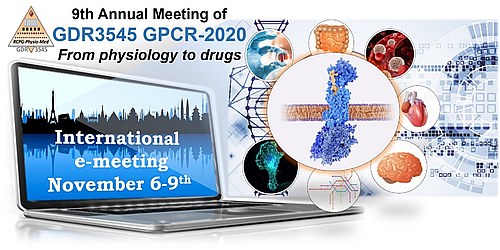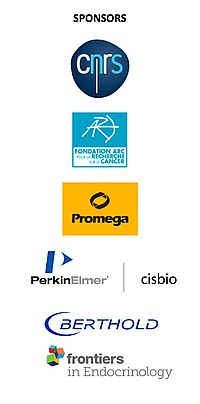9th GDR meeting November 6th-9th, 2020
9th GDR meeting November 6th-9th, 2020
Post on 25 September 2020

GDR meeting November 6 - 9, 2020
The 9th GDR3545-GPCR international meeting will be held online from November 6th to 9th 2020.
Eight sessions: Signaling networks - Compartmentalized signaling - Drug discovery - Metabolism & microbiome - Neurobiology & sensory biology - Structural biology and Computational approaches. A panel of outstanding speakers:
For students and early career investigators: 3 minute flash presentations and posters will be selected from submitted abstracts (deadline for abstract submission: October 15th, 2020).
Five 500€ poster prizes will be awarded. A workshop dedicated to students and early career investigators will be held on November 5th, 2020.
The 2020 GDR organizing committee looks forward to your participation to the next GDR3545-GPCR meeting in November 2020!
Scientific programme
Access to recordings via green Watch session button (passcode-protected). The recordings will expire on Nov 18, 2020.
Day 1: Friday, November 6, 2020
Session 1: Signaling networks Chair: Hélène Castel-Gandolfo & Séverine Morisset-Lopez
14.00-14.10 Welcome message – Opening
14.10-14.30 Nevin Lambert (Augusta University, USA):
Unconventional GPCR-G protein coupling
14.30-14.50 Robert B. Russell (Heidelberg University, Germany):
Illuminating G protein-coupling selectivity
14.50-15.10 Laurent Prezeau (IGF, Montpellier, France):
Nonclassical Ligand-Independent Regulation of Go Protein by an Orphan Class C G-Protein-Coupled Receptor
15.10-15.30 Ralf Jockers (Institut Cochin, France):
GPR50-Ctail cleavage and nuclear translocation: a new signal transduction mode for G protein-coupled receptors
15.30-15.45 Flash presentations 1
Romain Gerbier (Institut Cochin, France): Functional MT2/5-HT2C heteromers in mouse brain.
Alexander S. Hauser (University of Copenhagen, Denmark): The coupling selectivity landscape of 100 therapeutically relevant GPCRs.
Clémentine Philibert (Institut de Génomique Fonctionnelle, France): Characterization of endogenous mGlu2 receptor interactome in mouse brain.
Abigail Walker (Imperial College London, UK): Prostaglandin EP2 is directed to pro-inflammatory signal pathways via crosstalk with OTR and may
represent a novel therapeutic target for preterm labour.
15.45-16.10 Chat room session 1
Session 2: Compartmentalized signaling Chair: Romain Yvinec & Frédéric Jean-Alphonse
16.10-16.30 Jean-Pierre Vilardaga (Pittsburg, USA)
PTHR location biased signaling (endosomal vs membrane signaling) and in vivo consequences
16.30-16.50 Miriam Stoeber (University of Geneva, Switzerland)
Location bias signaling (endosomes, golgi)
16.50-17.10 Séverine Chaumont-Dubel (IGF, Montpellier, France)
Dynamic interactions of the 5-HT6 receptor with protein partners control dendritic tree morphogenesis
17.10-17.30 Grégoire Vandecasteele (Inserm Paris-Sud)
PDE4 and mAKAPβ are nodal organizers of β2-ARs nuclear PKA signaling in cardiac myocytes
(At the request of the speakers Jean-Pierre Vilardaga and Miriam Stoeber, their talks were not recorded)
17.30-17.45 Flash presentations 2
Silvia Sposini (Université de Bordeaux & Imperial College London): Visualization of GPCR endocytosis in neuronal dendrites using the ppH assay.
Alan Hegron (NYU, USA): GPCR endosomal signaling involved in chronic pain.
Khairunnisa Mentari Semesta (Duke University, USA): Dissecting novel GPCR transcriptional regulation using a high-throughput CRISPRi screen.
Gloria Somalo Barranco (Institut Cochin, France): Design, synthesis and biological characterization of photo-regulated melatonin receptor ligands in diabetes and neurodegenerative diseases.
17.45-18.10 Chat room session 2
18.10-19.00 Keynote lecture 1: Michel Bouvier (Université de Montréal, Canada)
Functional selectivity of GPCR signalling; also a matter of ‘confinement’
Day 2: Saturday, November 7, 2020
Session 3: Drug discovery I Chair: Hélène Castel-Gandolfo & Frédéric Jean-Alphonse
14.00-14.20 Rachel Friedman Ohana (Promega corporation, USA)
Generating chemical tools to study GPCR-ligand interactions by BRET in living cells
14.20-14.40 Laura Bohn (Scripps, USA)
Toward Directing Opioid Receptor Signaling to Refine Opioid Therapeutics
14.40-15.00 Jean-Marc Devaud (Toulouse, France)
Targeting an allatostatin receptor, a potential mediator of stress response in honey bees
15.00-15.20 Jean-Luc Galzi (Strasbourg, France)
GPCR ligands as drug targets
15.20-15.35 Discussion
(At the request of Laura Bohn, her talk was not recorded)
15.35-15.50 Flash presentations 3
Cécile Derieux (INSERM Tours, France): Bromide ions as a positive allosteric modulator on some GPCRs.
Michael Ippolito (Thomas Jefferson University, USA): Identification of β-arrestin-biased negative allosteric modulator of the β2-adrenergic receptor.
Nicola Dijon (University of Nottingham, UK): Use of a kinetic operational model to predict agonist binding affinities from functional data, at β1 and β2 adrenoreceptors.
Samuel Mailhot-Larouche (Université de Montréal, Canada): Selective desensitization of the M3 receptor: toward improvement of asthma treatment.
Session 4: Drug discovery II Chair: Séverine Morisset-Lopez & Eric Reiter
16.00-16.20 Ross Cheloha (Harvard, Boston, USA)
Nanobody-drug-conjugate at PTHR
16.20-16.40 Stephen J. Hill (University of Nottingham, UK)
CRISPR-Mediated Protein Tagging with Nanoluciferase to Investigate Native Chemokine Receptor Function and Conformational Changes
16.40-17.00 Philippe Rondard (IGF, Montpellier, France)
Nanobodies against mGluR
17.00-17.20 Géraldine Schlecht-Louf (Université Paris-Sud, France)
CXCR4 signaling controls dendritic cell location and activation at steady-state and in inflammation
17.20-17.35 Discussion
part 1 part 2 part 3
(At the request of Phillipe Rondard, his talk was not recorded)
17.35-17.50 Flash presentations 4
Justine Paradis (UCSD, USA): FAK and MEK co-targeting: a new multimodal precision therapy for GNAQ-driven uveal melanoma.
Marthe Vandeputte (Ghent University, Belgium): Application of a novel, stable bio-assay platform to assess biased agonism at the mu-opioid receptor.
Jan Hendrik Voss (University of Bonn, Germany): A molecular basis for the ultra-long residence time of the macrocyclic Gαq protein inhibitor FR900359.
Florence Miller (Berthold)
18.10-18.50 Keynote lecture 2: Bryan L. Roth (University of North Carolina, USA)
New chemical and synthetic biology technologies
Day 3: Sunday, November 8, 2020
Session 5: Metabolism, Microbiome Chair: Pablo Chamero & Eric Reiter
14.00-14.20 Thue W. Schwartz (The Panum Institute, Copenhagen, Denmark):
Enterochromaffin 5-HT Cells - A Major Target for GLP-1 and Gut Microbial Metabolites
14.20-14.40 Graeme Milligan (University of Glasgow, Glasgow, UK):
Short chain free fatty acids receptor
14.40-15.00 François Trottein (Pasteur Lille, France):
Gut Dysbiosis during Influenza Contributes to Pulmonary Pneumococcal Superinfection through Altered Short-Chain Fatty Acid Production
15.00-15.20 Jacques Pantel (INSERM, Paris, France):
Input of ghrelin receptor mutations in today’s understanding of the ghrelin system
15.20-15.35 Discussion
(At the request of Jacques Pantel, his talk was not recorded)
Flash presentations 5
Amélia Chorfa (Institut de Génomique Fonctionnelle, France): Mambaquaretin, a toxin from green mamba venom, a novel V2 receptor antagonist for the diagnosis and potential treatment of renal cancer.
Suli-Anne Laurin (Université de Montréal, Canada): Effect of the pharmacological chaperone UM0130866 on the cell-surface expression and signaling profile of melanocortin receptor type 4 (MC4R) variants associated with severe early-onset obesity.
Dayana Abboud (Université de Liège, Belgium): GPR101 drives growth hormone hypersecretion & gigantism in mice via constitutive activation of Gs and Gq/11.
George Thomas (Frontiers in Endocrinology)
Session 6: Neurobiology, sensory biology Chair: Lucie Pellissier & Pablo Chamero
16.00-16.20 Hiro Matsunami (Duke University, USA)
Odorant receptors
16.20-16.40 Jianfeng Liu (Wuhan, China)
A Cold-Sensing Receptor Encoded by a Glutamate Receptor Gene
16.40-17.00 Christophe Rochais (Caen, France)
5HTR ligand and Alzheimer
17.00-17.20 Pascal Dournaud (INSERM, Paris, France)
A simple novel approach for detecting blood-brain barrier permeability using GPCR internalization
17.20-17.35 Discussion
Flash presentations 6
Matevz Arcon (University of Aberdeen, UK): Ventral tegmental area 5-TH2C receptors modulate physical activity with ageing.
Jordi Haubrich (Institut de Génomique Fonctionnelle, France): A nanobody activating mGlu4 receptor discriminates between homo- and heterodimers.
Marc Lopez-Cano (University of Barcelona, Spain): Minimizing opioid-related adverse effects by remote local photoactivation of morphine.
Miriam Scarpa (University of Glasgow, UK): Phosphorylation of the M1 muscarinic acetylcholine receptor protects from neurodegeneration.
18.10-19.00 Keynote lecture 3:
Valery Grinevich (Zentralinstitut für Seelische Gesundheit, Mannheim, Germany)
How does a single neuropeptide exert pleoitropic effects? Focus on oxytocin
Day 4: Monday, November 9, 2020
Session 7: Structural biology Chair: Pascale Crépieux & Frédéric Jean-Alphonse
14.00-14.20 Martha Sommer (Charité Medical University Berlin, Germany)
An ERNEST assessment of arrestin-GPCR interactions
14.20-14.40 Martin J Lohse (Max Delbrück Center for Molecular Medicine, Berlin, Germany)
Stepwise activation of a class C GPCR begins with millisecond dimer rearrangement
14.40-15.00 Bernard Mouillac (IGF, Montpellier, France)
Cryo-EM structure of the vasopressin hormone-V2 receptor-Gs protein ternary complex
15.00-15.20 Esther Kellenberger (University of Strasbourg, France)
Structure function relationships of CCR5
15.20-15.35 Discussion
(At the request of Bernard Mouillac, his talk was not recorded)
Flash presentations 7
Antoniel Gomes (Institut des Biomolécules Max Mousseron, France): Coarse-grained molecular dynamics simulations to predict the coupling of GPCRs to their favorite intra-cellular partners.
Tomasz Maciej Stepniewski (Universitat Pompeu Fabra, Barcelona, Spain): Mechanistic insights on how arrestin recognizes the GPCR “phosphorylation barcode”.
Vaithish Velazhahan (University of Cambridge, UK): Structure of a class D GPCR dimer coupled to two G proteins.
Bruno Tillier (Synthelis)
Session 8: Computational approaches Chair: Pascale Crépieux & Romain Yvinec
16.00-16.20 David E. Gloriam (University of Copenhagen, Copenhagen, Denmark)
Discovery of Human Signaling Systems: Pairing Peptides to G Protein-Coupled Receptors
16.20-16.40 Graham Ladds ( University of Cambridge, UK)
Engineering a Model Cell for Rational Tuning of GPCR Signaling
16.40-17.00 Romain Yvinec (INRAE Nouzilly, France)
Mathematical modeling of GPCR-induced signaling.
17.00-17.20 Hugues Berry (INRIA, Lyon, France):
Calcium signaling in the microworld of fine astrocytic processes
17.20-17.35 Discussion
Flash presentations 8
Tonis Laasfeld (University of Tartu, Estonia): Machine learning quantification of ligand binding in live cells.
Mariona Torrens Fontanals (Universitat Pompeu Fabra, Barcelona, Spain): Molecular dynamics of GPCRs for everybody.
Guillermo Pérez-Hernandez (Charité University Berlin, Germany): Analysis of molecular dynamics simulations using residue neighborhoods.
Pedro Renault (Universitat Autonoma de Barcelona, Spain): Dynamical correlations reveal allosteric sites in the b2 adrenergic receptor.
18.10-18.50 Keynote lecture 4: Brian Kobilka (Stanford University, USA)
Structural insights into the dynamic process of G protein coupled receptor activation
(Please note that Brian Kobilka did not wish to be recorded. We are very sorry if you have missed the live session!)
18.50-19.50 Awards & Conclusions
Other Flash presentations
Signaling networks (starts at 0:00) Bermudez, Hegron, Godbole, Hsiao, Melli, Lazzaretti, Sayers, D’alessandro, Paradiso, Oishi,
Godoy-Marin, Batebi, Labani, Pottie, Richardson, Jockers, Agren, McDowel, Baccouch, Sachdev, Vijayakshmi.
Compartmentalized signaling (starts at 1:05:03) Sposini.
Drug discovery (starts at 1:08:28) Nesheva, Girault-Sotias, Burger, Foster.
Metabolism, Microbiome (starts at 1:20:41) Rabe
Neurobiology, Sensory biology (starts at 1:23:41) Argerich, De March, Teboul, Gomez-Acero, Sarasola, Valle-Leon, Pedard, Rafael-Guimaraes, Dam, Martynova
Structural biology (starts at 1:54:53) Weerasinghe
Computational approaches (starts at 1:58:07) Kooistra, Medel-Lacruz, Radam, Ding, Berchiche.

Attachments:
Flyer final new.pdf
flyer final.pdf
